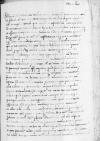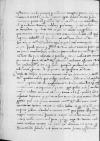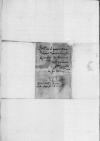Accepi Dominationis Vestrae ⌊⌋ et, quia responsivae sunt et negotia continent, quae saepius et saepius litteris reiterata sunt, ad necessaria descendam et brevibus me absolvam, nam satis superque et affatim litterarum Dominationem Vestram habituram credo, quibus vacare oportebit. Pergratissimae fuere ⌊serenissimae maiestati reginali⌋ expeditiones nuper habitae a ⌊caesare⌋ super relaxatione adohae antiquitus non solutae et de aliis pecuniis, que a novissime indictis adohis defalcari debent. Pauca restant pagenda videlicet ⌊Montis Sericoi⌋ causa, super qua gratia ⌊caesaris⌋ imploretur et iustitiae rigor seponatur, nam de iure succumbemus, cum durissimum sit contra stimulum calcitrare. Scribit mihi ⌊Levitius⌋, quod deberem vel Dominationem Vestram vel ipsum informare, de pecuniis exactis tempore sequestri quid factum sit, nam summa erat viginti milium cum uno. Postquam relaxatum est sequestrum, facta est mihi ratio de istis pecuniis ordinarie exactis, nam septem vel octo milia circiter fiscus accepit pro relevio, alia summa et pro oneribus et pro solvendis aliquibus legatis testamentariis erogata est, ut in rei veritate nihil apud fiscum remanserit, accepit tamen fiscus pro se quinque milia et quingentos ducatos, quos extorserant officiales tempore sequestri mulctarum seu poenarum nomine et illas sibi nullo iure vindicavit, nam secundum privilegiorum tenorem omnes paene a quocumque delicto, etiam a maiestatis laesae crimine indictae ⌊serenissimae maiestatis reginalis⌋ fisco cedere debent. Mihi tunc temporis non licuit cum illis in iudicium intrare, malui status possessionem accipere et hoc in aliud tempus discutiedum reservare. Si istae pecuniae modo possent recuperari, satis bene consultum foret, nam nihil de suo ⌊caesarea maiestas⌋ donaret, sed conversa in utilitatem suam
restitueret. Scribit ⌊Levitius⌋, quod medietas recuperari poterit, mihi videretur et satis bene consultum putarem, quod si ⌊Montis Sericoi⌋ feudum reintegrari posset vel per medium ⌊domini cardinalis supremi cancellarii⌋ vel per medium ⌊domini Valdesii⌋, quem tantopere Dominatio Vestra et laudat et commendat. Ex tunc Dominatio Vestra et hanc medietatem recuperabilem, de qua minime credo, nisi ex suprema ⌊caesaris⌋ liberalitate, vel ipsi ⌊supremo cancellario⌋ vel ipsi ⌊domino Valdesio⌋ cedat et donet, hoc namque ⌊serenissima maiestas reginalis⌋ habebit ratum et gratum, nam reintegrato ⌊Montis Sericoi⌋ feudo prout per ⌊illustrissimam dominam ducem⌋ felicis memoriae possidebatur, non parvum emolumentum accederet proventibus ⌊suae maiestatis reginalis⌋, nam licet illa pars abscissa et possessa per ⌊caesarem⌋ nullius sit utilitatis pro ⌊caesare⌋, pro ⌊serenissima tamen maiestate reginali⌋ plurimum utilitatis afferret. Dominatio Vestra est prudentissima et est super facto, quicquid consultius et melius sibi visum fuerit, id exequatur et perficere studeat.
Credo Dominationem Vestram memoria tenere esse hic in servitio ⌊serenissimae maiestatis reginalis⌋ quendam nobilem, qui vulgo vocabitur il Barone del Casalecto, nomen proprium est dominus ⌊Guglielmus de Braida⌋, oriundus ex ⌊regno Neapolitano⌋. Is secutus est partes ⌊regis Galliae⌋, sub quo multos annos militiae munus obivit, anno 1523-o militiae taedio affectus discessit ex ⌊Gallia⌋ et huc se contulit ⌊suam matrem⌋ videndi gratia, quam vita functam invenit. ⌊Maiestas reginalis⌋ ⌊illum⌋ inter suos servitores habere voluit et modo habet, is propter aliquod contingens cuperet habere indultum a ⌊cesarea maiestate⌋, quo posit aliquando ⌊regnum Neapolitanum⌋ invisere, a septem annis hic servit et ⌊caesari⌋ nullam hostilitatem fecit. Quapropter rogo Dominationem Vestram, velit totis viribus conari, nam facile hoc obtentum iri spero, quod huiusmodi indultum sub bona et cauta forma expediatur.
Quicquid pro eo Dominatio Vestra erogabit, curabo statim reponi et resarciri Dominationi Vestrae, cui et ego et ipse ⌊dominus Guglielmus⌋ plurimum pro suo labore debere fatebimur. Scribo et ⌊magnifico domino Cornelio⌋ super hoc ipso negotio, ut multiplicatis intercessoribus eo facilius res ipsa nostris votis acquiescat.
Novitates hic nullas habemus, quae sint vulgares, si quae sunt secretae, ex litteris aliorum, qui secretioribus intersunt, cognoscet Dominatio Vestra. Cui me et servitia mea perpetuo commendo.



